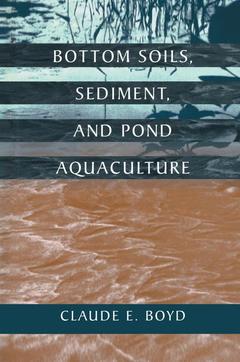Description
Bottom Soils, Sediment, and Pond Aquaculture, Softcover reprint of the original 1st ed. 1995
Coordinator: Boyd Claude E.
Language: English
Subjects for Bottom Soils, Sediment, and Pond Aquaculture:
Keywords
Flora; aquaculture; aquatic animals; classification; fauna; fish; nitrogen; physiology; respiration; soil; transport; ecotoxicology
Publication date: 09-2012
348 p. · 15.2x22.9 cm · Paperback
348 p. · 15.2x22.9 cm · Paperback
Description
/li>Contents
/li>Comment
/li>
Aquaculture pond managers measure water-quality variables and attempt to maintain them within optimal ranges for shrimp and fish, but surprisingly little attention is paid to pond soil condition. Soil-water interactions can strongly impact water quality, and soil factors should be considered in aquaculture pond management. The importance of soils in pond management will be illustrated with an example from pond fertilization and another from aeration. Pond fertilization may not produce phytoplankton blooms in acidic ponds. Total alkalinity is too low to provide adequate carbon dioxide for photosynthesis, and acidic soils adsorb phosphate added in fertilizer before phytoplankton can use it. Agricultural lime stone application can raise total alkalinity and neutralize soil acidity. The amount of limestone necessary to cause these changes in a pond depends on the base unsaturation and exchange acidity of the bottom soil. Two ponds with the same total alkalinity and soil pH may require vastly different quantities of limestone because they differ in exchange acidity. Aeration enhances dissolved oxygen concentrations in pond water and permits greater feed inputs to enhance fish or shrimp production. As feeding rates are raised, organic matter accumulates in pond soils. In ponds with very high feeding rates, aeration may supply enough dissolved oxygen in the water column for fish or shrimp, but it may be impossible to maintain aerobic conditions in the surface layers of pond soil. Toxic metabolites produced by microorganisms in anaerobic soils may enter the pond water and harm fish or shrimp.
Preface. Symbols. Abbreviations. Atomic weights. Soils in pond aquaculture. Physical, chemical, and mineralogical properties of soils. Soil nutrients. Exchange of dissolved substances between soil and water. Soil organic matter, anaerobic respiration and oxidation-reduction. Sediment. Relationships to aquatic animal production. Pond bottom management. Pond bottom soil analyses.
An excellent text for aquaculturists to improve their knowledge and pond management skills American Fisheries Society, ... a masterly text by one of the most productive and influential of pond aquaculture researchers ... Nowhere else is it possible to find such an authoritative account ... - Aquaculture, A must for any library that maintains holdings on fish, aquaculture, or soil science. - Choice, An excellent text for aquaculturists to improve their knowledge and pond management skills American Fisheries Society, An excellent text for aquaculturists to improve their knowledge and pond management skills American Fisheries Society, ... a masterly text by one of the most productive and influential of pond aquaculture researchers ... Nowhere else is it possible to find such an authoritative account ... - Aquaculture, A must for any library that maintains holdings on fish, aquaculture, or soil science. - Choice, ... a masterly text by one of the most productive and influential of pond aquaculture researchers ... Nowhere else is it possible to find such an authoritative account ... - Aquaculture News, An excellent text for aquaculturists to improve their knowledge and pond management skills - American Fisheries Society, A must for any library that maintains holdings on fish, aquaculture, or soil science - Choice, ... a masterly text by one of the most productive and influential of pond aquaculture researchers ... Nowhere else is it possible to find such an authoritative account ... - Aquaculture News
© 2024 LAVOISIER S.A.S.
These books may interest you

Pond Conservation in Europe 158.24 €



